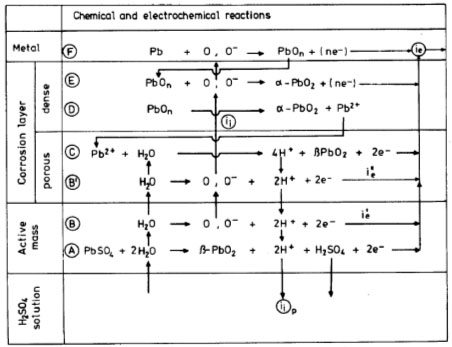One of the processes that take place during battery operation is corrosion of the spines (grids) of positive battery plates, which affects battery performance. Fundamental investigations have been conducted and experimental methods have been developed at Lead-Acid Battery Department aimed to study this process.
Experimental information. Special tubular electrodes are prepared and weight measurements are employed to evaluate the steady-state corrosion rate of the spines. Corrosion rate is measured at three different operation modes: continuous polarization, discontinuous polarization and charge–discharge cycling. The impact of different alloys is also investigated. The influence of active mass thickness on spine corrosion rate and corrosion layer phase composition is studied. The effect of polarization conditions on corrosion rate and composition of CL is determined. Experimental information about oxygen evolution effect on CL properties is provided. The main experimental results can be summarized as follow:
 The active mass reduces the corrosion rate on both types of alloys: lead and lead-antimony The active mass reduces the corrosion rate on both types of alloys: lead and lead-antimony
 Highest corrosion rate of lead is observed under charge-discharge conditions and lowest on continuous polarization Highest corrosion rate of lead is observed under charge-discharge conditions and lowest on continuous polarization
 For lead-antimony alloys the correlation is just the opposite For lead-antimony alloys the correlation is just the opposite
Theoretical considerations. The positive plate as electrode system can be represented as follows:
|
 |
H2SO4 (O2/H2O)
PbO2/H2SO4 (O2/H2O) |
|
The obtained experimental data is interpreted in the light of the oxygen model. This model allows revealing the effect of Sb on corrosion rate and phase composition of CL. The elementary reactions and their localization are studied. The plate structure and the reactions that proceed can be represented schematically as follows:

The obtained experimental results are in good agreement with theoretical concepts and provide practical information for improving the characteristics of tubular batteries.
References
- T. Rogachev, G. Papazov, D. Pavlov, Influence of Operating Conditions of Tubular Batteries on the Corrosion Rate of the Spine of Lead Dioxide Plates, Progress in Batteries and Solar Cells, 2 (1979) 145
- G. Papazov, T. Rogachev, D. Pavlov, J. Garche, K. Wiesener, Influence of Lead Dioxide Active Mass on the Grid Corrosion Rate of the Positive Lead-Acid Battery Plates, J. Power Sources, 6 (1980) 15
- T. Rogachev, G. Papazov, D. Pavlov, The Effect of Current Density and Thickness of Active Mass Upon the Corrosion Rate of the Spines of Lead-Acid Battery Plates, J. Power Sources, 10 (1983) 291
Keywords: tubular LAB plates, tubular plate spines, corrosion of Pb, lead-antimony alloy, continuous LAB polarization, discontinuous LAB polarization, LAB charge–discharge cycling, corrosion layer on LAB plates |
